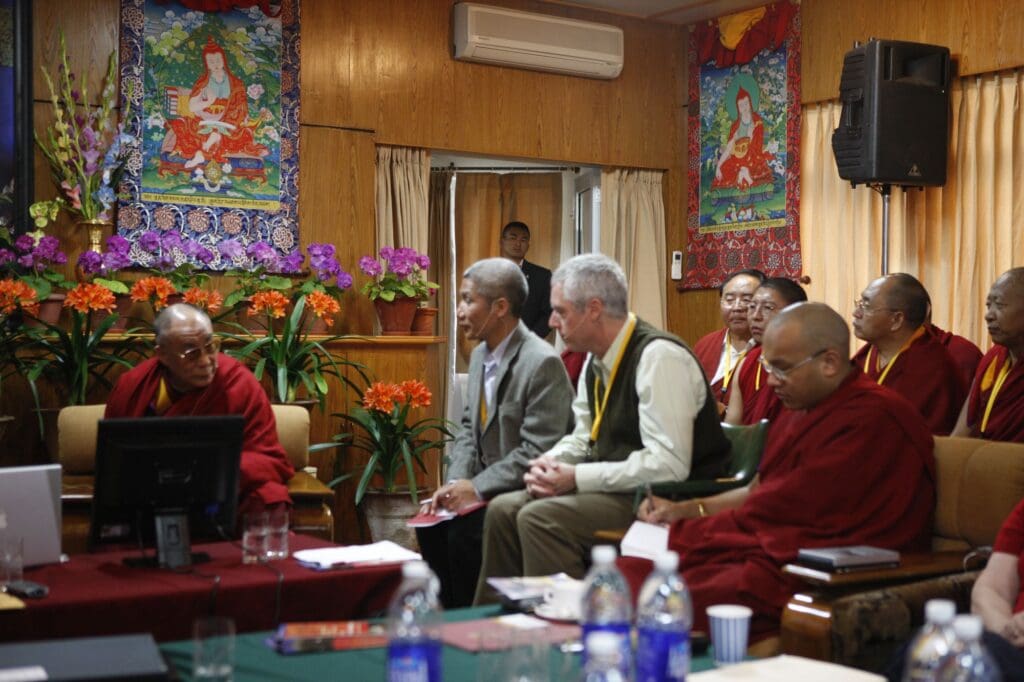Filmed during Mind & Life Institute’s “Mind & Life XVIII: Attention, Memory, and Mind” on April 6-10, 2009.
Mental Processes Underlying Attention, Visual Perception, and Cognitive Control
SPEAKER: Anne Treisman
Attention is a fuzzy concept that we try to capture in a variety of forms to study it in the lab. The main meaning is the selection of relevant information when the mind is overloaded or distracted. One dimension along which attention can vary is from sharply focused to broadly spread. Each setting may yield different information, from the detailed structure of an object with focused attention to the gist of a scene with more global attention. One set of experimental findings suggest a conclusion that is not easily available to introspection: this is that focused attention plays a role in binding features (like shape, color, or motion) to form integrated objects in visual perception. It prevents mistakes like seeing a blue shirt when the person is actually wearing a green shirt and blue pants. A similar function may be shown in higher level conceptual thinking, where attention is needed to create and hold more complex ideas in mind and in working forms of memory.
Is the role of attention limited to conscious perception and thought, leaving a whole complex set of implicit processes unaffected, or are there limits and controls also on what goes on unconsciously? Many recent studies of both normal people and patients with brain damage, for instance, have shown that our behavior and brains can be affected by cues in the environment of which we are quite unaware. Can access to unconscious information become easier through training in meditation? What other effects can meditation training have on attention? We took some standard tests from Western psychology and made some preliminary studies of experienced meditators, testing whether meditation could change the breadth of focus, the efficiency of focus, the overall capacity of attention, or the ability to move between different levels of processing. Our preliminary results suggest that the significant effects have been mainly on the higher levels of perception, where there is more flexibility. We found little evidence that meditation changed access to earlier sensory levels. Do these results accord well with what the outcomes of these meditation practices are?
Paying Attention to Awareness: “Attention” (manasikārā), “Mindfulness” (sati) and “Clear Comprehension” (samapajañña)
SPEAKER: Rupert Gethin
One of the distinctive features of Theravāda systematic thought (abhidhamma) is the detailed account it provides of the processes in which the mind becomes aware of and handles “objects” (classified as sense-data, the mind itself and abstract concepts). According to this account consciousness is the functioning, or simply assemblage, of complex and fast moving mental events and processes in which numerous discrete “mental qualities” (cetasika) – encompassing both the basic functions and emotions of the mind – interact at various stages to create our experience of the world. Within this synthetic process particular mental qualities are highlighted as performing very specific functions such as attention, categorizing, and also mindfulness, but always in simultaneous association with other mental qualities. The way the mind handles and pays attention to the various objects of consciousness at the basic level of awareness is considered crucial in this endeavour. This means that much of Buddhist contemplative practice involves a kind of meta-awareness: self-monitoring the processes by which the mind is aware of and pays attention to objects of consciousness. Questions to be discussed include: how do such Buddhist accounts of these faculties relate to contemporary definitions of “mindfulness” in scientific studies? How can we understand the relation between attention and memory in the practice of mindfulness?
PANELISTS:
His Holiness the 14th Dalai Lama
Adele Diamond
Shaun Gallagher
Amishi Jha
Thupten Jinpa
David Meyer
Elizabeth Phelps
Cliff Saron
B. Alan Wallace
Participants

Anne Treisman, PhD
Princeton


